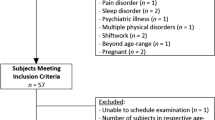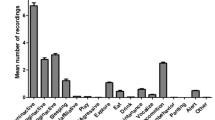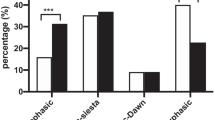Abstract
The aim of the study was to elucidate an influence of artificial dusk on sleep of healthy sleepers. Twenty-six participants with a normal 5–6-day weekly active schedule, sleeping single in bedroom and naïve to the primary aim of the study, completed two consecutive arms, each consisting of 7 days baseline, 13 days intervention, and 8 days follow-up. The intervention was dawn and dusk simulation (dusk) compared to dawn and a rectangular light–dark switch prior to sleep time (lights off). The 30-min dusk signal was preceded by 10 min of constant light to be similar in the overall light dose to the 17-min lights off signal. Throughout the study, subjects filled out a sleep diary immediately before and after sleep and wore actiwatches. Saliva for melatonin ELISA and circadian phase estimation was sampled prior to bedtime at home on days 7 or 8, 13 or 14 and 20 of each arm. Circadian phase remained unchanged throughout the study. Of the thirteen variables analysed, only one showed a difference: the number of minutes with movements during the first 40 min of the sleep episode was lower after dusk presentation compared to both lights off presentation and pre- and post-dusk days (P < 0.05). In the final evaluation, 42–45 % of subjects spontaneously remarked on an improved falling asleep with dusk (P = 0.057 or P = 0.041 if include 7 withdrawn subjects), corroborating objective measurements. The results indicate that artificial dusk induces a deeper initial sleep period.



Similar content being viewed by others
References
Boulos Z, Macchi MM. Season- and latitude-dependent effects of simulated twilights on circadian entrainment. J Biol Rhythms. 2005;20:132–44.
Daan S, Albrecht U, van der Horst GT, Illnerová H, Roenneberg T, Wehr TA, Schwartz WJ. Assembling a clock for all seasons: are there M and E oscillators in the genes? J Biol Rhythms. 2001;16:105–16.
Terman M, Schlager D, Fairhurst S, Perlman B. Dawn and dusk simulation as a therapeutic intervention. Biol Psychiatry. 1989;25:966–70.
Terman M, Schlager DS. Twilight therapeutics, winter depression, melatonin, and sleep. In: Montplaisir J, Godbout R, editors. Sleep and biological rhythms. New York: Oxford University Press; 1990. p. 113–28.
Avery DH, Eder DN, Bolte MA, Hellekson CJ, Dunner DL, Vitiello MV, Prinz PN. Dawn simulation and bright light in the treatment of SAD: a controlled study. Biol Psychiatry. 2001;50:205–16.
Terman M, Terman JS. Controlled trial of naturalistic dawn simulation and negative air ionization for seasonal affective disorder. Am J Psychiatry. 2006;163:2126–33.
Norden MJ, Avery DH. A controlled study of dawn simulation in subsyndromal winter depression. Acta Psychiatr Scand. 1993;88:67–71.
Danilenko KV, Wirz-Justice A, Kräuchi K, Cajochen C, Weber JM, Fairhurst S, Terman M. Phase advance after one or three simulated dawns in humans. Chronobiol Int. 2000;17:659–68.
Danilenko KV, Wirz-Justice A, Kräuchi K, Weber JM, Terman M. The human circadian pacemaker can see by the dawn’s early light. J Biol Rhythms. 2000;15:437–46.
Terman M, Terman JS. Circadian rhythm phase advance with dawn simulation treatment for winter depression. J Biol Rhythms. 2010;25:297–301.
Giménez MC, Hessels M, van de Werken M, de Vries B, Beersma DG, Gordijn MC. Effects of artificial dawn on subjective ratings of sleep inertia and dim light melatonin onset. Chronobiol Int. 2010;27:1219–41.
Gabel V, Maire M, Reichert CF, Chellappa SL, Schmidt C, Hommes V, Viola AU, Cajochen C. Effects of artificial dawn and morning blue light on daytime cognitive performance, well-being, cortisol and melatonin levels. Chronobiol Int. 2013;30:988–97.
Arakawa K, Shirakawa S, Kobayashi T, Oguri M, Kamei Y, Tumura T. Effects of the gradually increasing dawn light stimulation on sleep feeling. Psychiatry Clin Neurosci. 1999;53:247–8.
Thorn L, Hucklebridge F, Esgate A, Evans P, Clow A. The effect of dawn simulation on the cortisol response to awakening in healthy participants. Psychoneuroendocrinology. 2004;29:925–30.
Kondo M, Tokura H, Wakamura T, Hyun KJ, Tamotsu S, Morita T, Oishi T. Combined influences of gradual changes in room temperature and light around dusk and dawn on circadian rhythms of core temperature, urinary 6-hydroxymelatonin sulfate and waking sensation just after rising. Coll Antropol. 2007;31:587–93.
Kondo M, Tokura H, Wakamura T, Hyun KJ, Tamotsu S, Morita T, Oishi T. Influences of twilight on diurnal variation of core temperature, its nadir, and urinary 6-hydroxymelatonin sulfate during nocturnal sleep and morning drowsiness. Coll Antropol. 2009;33:193–9.
Van De Werken M, Giménez MC, De Vries B, Beersma DG, Van Someren EJ, Gordijn MC. Effects of artificial dawn on sleep inertia, skin temperature, and the awakening cortisol response. J Sleep Res. 2010;19:425–35.
Fromm E, Horlebein C, Meergans A, Niesner M, Randler C. Evaluation of a dawn simulator in children and adolescents. Biol Rhythm Res. 2011;42:417–25.
Thompson A, Jones H, Gregson W, Atkinson G. Effects of dawn simulation on markers of sleep inertia and post-waking performance in humans. Eur J Appl Physiol. 2014;114:1049–56.
Leppämäki S, Meesters Y, Haukka J, Lönnqvist J, Partonen T. Effect of simulated dawn on quality of sleep—a community-based trial. BMC Psychiatry. 2003;3:14.
Noguchi H, Sakaguchi T, Shirakava S, Komada Y. Effects on simulated dawn lighting on awakening. J Illum Eng Soc. 2001;2001:49–56.
Terman M, MacMahan I. Reset your inner clock: the drug-free way to your best-ever sleep, mood and energy. New York: Avery; 2013.
Gasio FP, Kräuchi K, Cajochen C, Ev Someren, Amrhein I, Pache M, Savaskan E, Wirz-Justice A. Dawn-dusk simulation light therapy of disturbed circadian rest–activity cycles in demented elderly. Exp Gerontol. 2003;38:207–16.
Buysse DJ, Reynolds CF 3rd, Monk TH, Berman SR, Kupfer DJ. The Pittsburgh Sleep Quality Index: a new instrument for psychiatric practice and research. Psychiatry Res. 1989;28:193–213.
Bastien CH, Vallières A, Morin CM. Validation of the Insomnia Severity Index as an outcome measure for insomnia research. Sleep Med. 2001;2:297–307.
Torsvall L, Åkerstedt T. A diurnal type scale: construction, consistency and validation in shift work. Scand J Work Environ Health. 1980;6:283–90.
International Classification of Sleep Disorders. Diagnostic and coding manual. 2nd ed. Westchester, IL: American Academy of Sleep Medicine; 2005.
Gillberg M, Kecklund G, Akerstedt T. Relation between performance and subjective ratings of sleepiness during a night awake. Sleep. 1994;17:236–41.
Danilenko KV, Antyufeev VS, Verevkin EG, Wirz-Justice A, Cajochen C. The hockey-stick method to estimate evening dim light melatonin onset (DLMO) in humans. Chronobiol Int. 2014;31:349–55.
Walmsley L, Hanna L, Mouland J, Martial F, West A, Smedley AR, Bechtold DA, Webb AR, Lucas RJ, Brown TM. Colour as a signal for entraining the mammalian circadian clock. PLoS Biol. 2015;13:e1002127.
Szymusiak R, McGinty D. Hypothalamic regulation of sleep and arousal. Ann NY Acad Sci. 2008;1129:275–86.
Morgenthaler T, Alessi C, Friedman L, Owens J, Kapur V, Boehlecke B, Brown T, Chesson A Jr, Coleman J, Lee-Chiong T, Pancer J, Swick TJ. Standards of Practice Committee; American Academy of Sleep Medicine. Practice parameters for the use of actigraphy in the assessment of sleep and sleep disorders: an update for 2007. Sleep. 2007;30:519–29.
Acknowledgments
The study was granted by Philips Consumer Lifestyle®. We thank study participants for completion of the study, Ekaterina Cheresiz for melatonin assay, Christian Niederberger, Jakob Weber (both—Bühlmann laboratories), Darren Cook (http://www.myassays.com/) and Evgeniya Stepkina for melatonin assay help, Marina Giménez for actimetry consulting, Elena Danilenko and Evgeniy Verevkin for processing data, Anna Wirz-Justice for English editing the manuscript.
Author information
Authors and Affiliations
Corresponding author
Ethics declarations
Conflict of interest
None of the authors have any potential conflicts of interest associated with this research.
Rights and permissions
About this article
Cite this article
Danilenko, K.V., Hommes, V. Influence of artificial dusk on sleep. Sleep Biol. Rhythms 14, 47–53 (2016). https://doi.org/10.1007/s41105-015-0020-z
Received:
Accepted:
Published:
Issue Date:
DOI: https://doi.org/10.1007/s41105-015-0020-z




